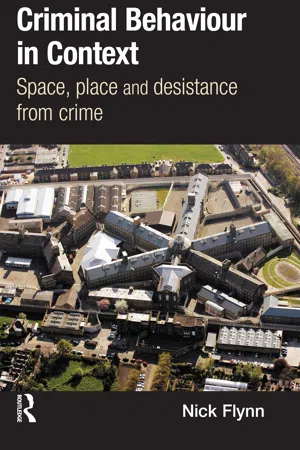
- 302 pages
- English
- ePUB (mobile friendly)
- Available on iOS & Android
About this book
This book examines the extent to which criminal desistance – 'the change process involved in the ending of criminal behaviour' – is affected by personal and social circumstances which are place specific. Grounded in criminological spatial analysis, as well as more general social scientific investigations of the role of space and place in contemporary social, economic and cultural life, it examines why large numbers of prisoners in the United States and the United Kingdom appear to be drawn from – and after release return to – certain urban neighbourhoods.
In doing so Criminal Behaviour in Context assesses the effect of this unique life course experience on the pathways and choices open to ex-prisoners who attempt to give up crime. Including new data on the geographical distribution of offenders, interviews with serving prisoners, and drawing on theories about social context, identity and subjectivity, it discusses the implications of the evidence and arguments presented for prisoner reintegration policy and practice.
Frequently asked questions
- Essential is ideal for learners and professionals who enjoy exploring a wide range of subjects. Access the Essential Library with 800,000+ trusted titles and best-sellers across business, personal growth, and the humanities. Includes unlimited reading time and Standard Read Aloud voice.
- Complete: Perfect for advanced learners and researchers needing full, unrestricted access. Unlock 1.4M+ books across hundreds of subjects, including academic and specialized titles. The Complete Plan also includes advanced features like Premium Read Aloud and Research Assistant.
Please note we cannot support devices running on iOS 13 and Android 7 or earlier. Learn more about using the app.
Information
Table of contents
- Cover Page
- Half title
- Title Page
- Copyright Page
- Dedication
- Contents
- Acknowledgments
- Participant list
- Glossary of terms and phrases
- Introduction A common frame of spatial reference
- 1 Criminal desistance in context
- 2 From A to B and back again: the revolving door between place of residence and imprisonment
- 3 Place, the community and the offender
- 4 The hidden limitations and possibilities of everyday life
- 5 ‘On the up’: pre-prison experiences
- 6 ‘On the in’: the impact of imprisonment
- 7 ‘On the out’: after-prison experiences
- 8 Implications
- Appendix: A note on the methodology
- Bibliography
- Index